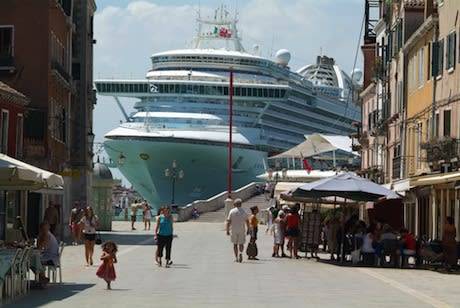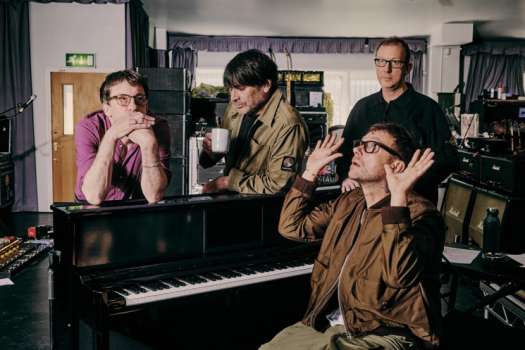Twenty years ago, 200,000 people resided in Venice, Italy; today, the population is hovering close to 50,000 residents. This alarming decline in population is being fuelled by mass tourism, something that parallels many cities throughout the world.
The quotidian Venice experience is examined in Andreas Pichler's The Venice Syndrome, with tourists crowding into Piazza San Marco and various other places throughout the city, snapping photos and "making memories" by day. By night, the city is desolate, with the tourists having departed, leaving the metropolis deserted until the next horde of interchangeable shutterbugs arrive the next day. What Pichler reveals is just how an industry that should fuel an economy is ultimately decimating a coveted locale.
Young people leave to find jobs elsewhere on the mainland, while others depart to escape the madness of the tourism industry. The price of a home in Venice has skyrocketed, as the cost of properties continues to be driven-up by foreigners and real estate speculators. Rental prices are also climbing, leading many to vacate and seek more affordable homes elsewhere. Elderly residents that have lived in Venice for their entire lives — many of whom are part of a Venetian lineage dating back several generations — now fear they will be unable to carry on in this environment.
Much worse is Venice's fragile environmental condition. A city known for its canals and water access is being exploited, with the enormous cruise ships that dock in Venice's harbour, dwarfing buildings, churning up the lagoon and disturbing residents.
These monstrous cruise ships arrive and depart daily, depositing their human cargo for the day at the Venice docks, while a fleet of buses come and go at regular intervals, each one dropping off tourists to explore the city for a few hours. The visitors wander around taking pictures, believing that they are "experiencing" Venice, only to get back into their ship or bus and take off for their next destination.
Meanwhile, Venetians are clamouring to make money from these people. Many local businesses, such as cafes and bars, are desperately trying to make ends meet. Tourists walk up and down the crowded streets while owners of cafes stand along the side, urging potential customers to come inside and make a purchase.
One would think that the tourism would be a major cash injection for the city; however, much of the money that's funnelled into Venice goes directly to international corporations that have taken a firm grasp on the city's economy.
Venice's city services have suffered with the declining population, with much of the emphasis being diverted to the mainland. The primary postal facility was recently sold to the Benetton Group, while a multi-million dollar medical facility recently opened on the mainland, leaving Venice residents to travel a great distance in order to access modern health care.
Pichler succinctly underscores the impact this industry has had upon Venice, juxtaposing scenes of tourists with that of residents off the beaten trail. Looking past the throngs of people, there is a beautiful residential layer to Venice that has been long overlooked; it is through a series of interviews with the Venetian residents that we see all that is being taken for granted.
The Venice Syndrome is a fascinating and alarming look at what human traffic is capable of and, much more importantly, what we are doing throughout the world. While getting out, exploring new and exciting places is certainly admirable, one has to question the ultimate cost of mass tourism.
(Kinosmith)The quotidian Venice experience is examined in Andreas Pichler's The Venice Syndrome, with tourists crowding into Piazza San Marco and various other places throughout the city, snapping photos and "making memories" by day. By night, the city is desolate, with the tourists having departed, leaving the metropolis deserted until the next horde of interchangeable shutterbugs arrive the next day. What Pichler reveals is just how an industry that should fuel an economy is ultimately decimating a coveted locale.
Young people leave to find jobs elsewhere on the mainland, while others depart to escape the madness of the tourism industry. The price of a home in Venice has skyrocketed, as the cost of properties continues to be driven-up by foreigners and real estate speculators. Rental prices are also climbing, leading many to vacate and seek more affordable homes elsewhere. Elderly residents that have lived in Venice for their entire lives — many of whom are part of a Venetian lineage dating back several generations — now fear they will be unable to carry on in this environment.
Much worse is Venice's fragile environmental condition. A city known for its canals and water access is being exploited, with the enormous cruise ships that dock in Venice's harbour, dwarfing buildings, churning up the lagoon and disturbing residents.
These monstrous cruise ships arrive and depart daily, depositing their human cargo for the day at the Venice docks, while a fleet of buses come and go at regular intervals, each one dropping off tourists to explore the city for a few hours. The visitors wander around taking pictures, believing that they are "experiencing" Venice, only to get back into their ship or bus and take off for their next destination.
Meanwhile, Venetians are clamouring to make money from these people. Many local businesses, such as cafes and bars, are desperately trying to make ends meet. Tourists walk up and down the crowded streets while owners of cafes stand along the side, urging potential customers to come inside and make a purchase.
One would think that the tourism would be a major cash injection for the city; however, much of the money that's funnelled into Venice goes directly to international corporations that have taken a firm grasp on the city's economy.
Venice's city services have suffered with the declining population, with much of the emphasis being diverted to the mainland. The primary postal facility was recently sold to the Benetton Group, while a multi-million dollar medical facility recently opened on the mainland, leaving Venice residents to travel a great distance in order to access modern health care.
Pichler succinctly underscores the impact this industry has had upon Venice, juxtaposing scenes of tourists with that of residents off the beaten trail. Looking past the throngs of people, there is a beautiful residential layer to Venice that has been long overlooked; it is through a series of interviews with the Venetian residents that we see all that is being taken for granted.
The Venice Syndrome is a fascinating and alarming look at what human traffic is capable of and, much more importantly, what we are doing throughout the world. While getting out, exploring new and exciting places is certainly admirable, one has to question the ultimate cost of mass tourism.




